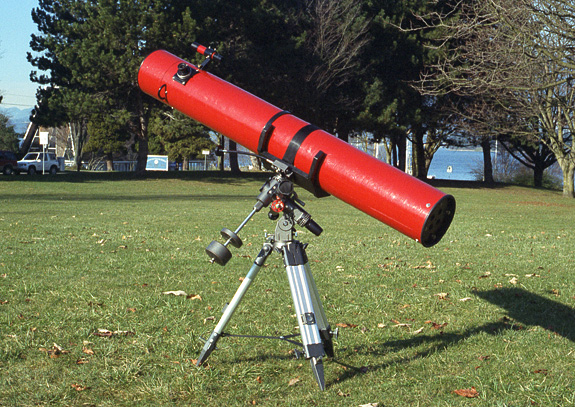
Attention to detail is what separates a regular Newtonian reflector from one optimized for high-contrast performance. This 6-inch f/9 uses every trick in the ATM’s book to deliver superb planetary and deep-sky views.
This was the first telescope I made using my own optics. Like most telescope makers, I got started the easy way, by building Dobsonians with mirrors ground by others. But one day I got bit with the mirror-making bug. I blame my friend Lance Olkovick, our local club’s mirror-making ace. But why a long-focus 6-inch? At the time I was a hardcore Jupiter junkie and was convinced that a long-focus Newtonian would deliver excellent views of my favourite subject. I also wanted to prove a point.
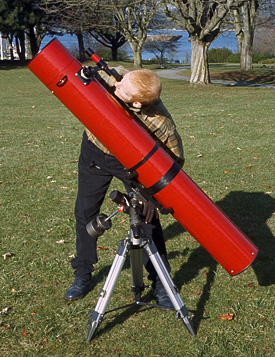
In the mid-1990s, apochromatic refractors were starting to become quite popular, but hadn’t yet become the mass-produced scopes you see today. Back then, Astro-Physics was pretty much the only game in town and their scopes were touted as the last word in viewing excellence, especially when it came to the planets. But it always struck me as odd that a 6-inch refractor was regarded as a first-rate planetary scope, but the same aperture in a reflector was considered barely adequate. Could an apochromatic refractor lens really be that much better than a quality mirror? I was skeptical. To find out, I built the Big Red One.
Design First
I began my project by choosing design parameters that matched those typical of commercial apochromats. I settled on a 6-inch f/9 optical system. While smaller apertures can show a lot, I wanted the greater light grasp of a 6-inch telescope. Experience has shown that with this aperture planetary details become much more certain that with smaller scopes. A 6-inch also puts a truly astonishing number of deep-sky objects within reach.
There are good reasons for the popularity of the f/9 focal ratio among modern apochromatic refractors. The tube length is short enough to be manageable while still retaining the benefits traditionally ascribed to long-focus instruments. These include a generous image scale, which yields high-magnification views with medium-focal-length eyepieces. Add a high-quality Barlow lens, and it is possible to minimize the need for short-focal-length eyepieces, which often lack the eye relief necessary for relaxed viewing.
Furthermore, the slowly converging f/9 light cone is much easier for simple eyepieces designs to handle. It’s amazing how well the previous generation of orthoscopic, Erfle, and Plössl eyepieces perform with moderate and long f/ratios. These eyepieces lack the extra correcting lenses found in some modern eyepieces designed with fast-f/ratio telescopes in mind. Because less glass can be better than more, at least when the quest is for maximum contrast and light transmission, the use of simple eyepieces became part of my design criteria.
Another important benefit of long f/ratios is the relatively lax collimation tolerances compared with faster mirrors. Rather then rendering an excuse for casual collimation standards, these tolerance provide the opportunity to collimate with greater precision and the assurance that once adjusted a telescope will remain collimated during use.
The size of a Newtonian’s secondary obstruction is minimized when a low-profile focuser is used in conjunction with a long f/ratio mirror. Such a configuration makes it possible to use a secondary mirror that’s less than 15% the diameter of the primary.
The principal limitation of the Newtonian design is often attributed to the secondary -mirror obstruction. Nevertheless, telescope experts such as Jean Texereau note that this image degradation can be greatly minimized. Because an f/9 light cone is very narrow where it meets the secondary mirror, a relatively small mirror can be used, thus reducing the size of the obstruction. An astonishing amount of literature has been devoted to this topic, and the range of opinions is wide, to say the least. One detailed discussion appears in Harold Richard Suiter’s Star Testing Astronomical Telescopes (Willmann-Bell, 1994). After much deliberation, I settled on an secondary with a ¾-inch minor axis. According to Suiter and Texereau, obstructions this small (only 12½ percent of the aperture’s diameter) degrade the image very slightly — certainly below the level that can be easily perceived in the eyepiece.
It’s All Done With Mirrors
Without a doubt, the single most important aspect of building a high-performance Newtonian is the quality of the primary mirror. It has to be exceptionally well polished, accurately figured, and free of zones and surface roughness. Fortunately, here again, the choice of a long f/ratio has important benefits. many telescope makers are familiar with the Millies-Lacroix tolerance envelope, which graphically illustrates the range of surface correction for a mirror of acceptable quality. The envelope is extremely narrow for short ratios, but generously wide of long ones. This implies that long-focal-length mirrors can tolerate far greater figuring errors than those of short focal length. It is also easier to work with a long-focus mirror toward a truly excellent figure and verify it with the simple Foucault test.
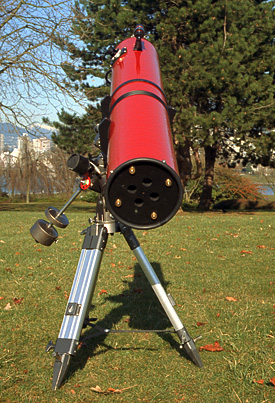
Since the degree of parabolization required is small for a 6-inch f/9 mirror, the time-tested method of first producing a good sphere and then proceeding to a parabola works very well. The benefits of this technique are as subtle as they are important. The Foucault test is a null test for spheres, and as such the slightest imperfections stand out in stark relief. Early on I decided that the sphere would be the battlefield on which I would fight zones and surface roughness.
Obtaining a smooth, zone-free f/9 sphere was considerably more demanding than I had expected. It was easy, for example, to see the differences produced by working the mirror using pitch of different harnesses and subtly different polishing strokes. After much experimentation I found the combination of soft pitch and a slow, gentle 1/3-diamter stroke with a full-size tool produced a smooth zone-free surface. The experience also left me wondering just how much roughness can hide in the dark Foucault shadows of a short f/ratio mirror. Glass pushers sometimes become so fixated on a mirror’s figure that surface roughness becomes a secondary issue, especially with fast mirrors where such defects are difficult to detect. Could surface roughness be one reason why so many Newtonians fail to produce high-contrast images?
I made several tries a parabolizing my mirror before arriving at the final figure. Because the overall correction was small, it was easy to return the mirror to a sphere if I didn’t like how the figuring was progressing. Several pretty good figures were polished back to spheres in my search for perfection, and my notebook reads like the diary of a mad telescope maker. I recall the trepidation with which I took a 1/12-wave paraboloid back to a sphere, uncertain I could do better.
After much effort the primary mirror was finished. Although the final wave-error calculation implied a surface figure good to 1/29 wave, such measurement accuracy is beyond that possible with the Foucault test. i was, however, satisfied that the primary mirror was very good, and perhaps even excellent.
Fade To Black
The high-contrast images I sought from my telescope required more than just a smooth, well-polished mirror. The telescope’s baffling system had to be optimized. For most Newtonian telescopes, baffling consists of a coat of flat black paint on the inside of the tube. This is obviously better than nothing, but it is far short of the complete baffling systems found in today’s quality refractors. The principle behind baffling is simply to ensure that only light coming to focus for the telescope’s objective reaches the eyepiece.
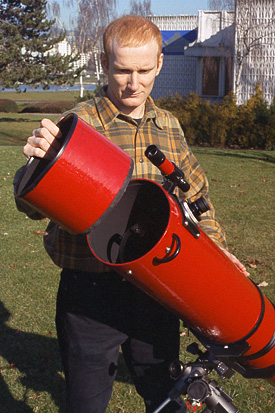
Refractors usually accomplish this with a series of ring baffles spaced along the length of the tube, hugging the converging cone of light as it narrows to a focus. Some advocate a system of ring baffles for Newtonians, but these have drawbacks. Not only are they time consuming to make and awkward to install, but without the correct dimensions and spacing, they either become ineffective or, worse, vignette the light path. A greater drawback is that, without elaborate modification, they will force air moving inside the telescope tube into the light path and thus degrade the image.
In my mind it is much simpler to rough up the inside of the tube — in effect creating many tin baffles. I recalled a note in a back issue of S&T that described sprinkling sawdust onto the first coat of black paint before it dried. A second coat of paint made the surface truly black. Rather than sawdust, I used crushed walnut shells (a product sold commercially as Slip-Not). The resulting roughness made for a tube that did an impressive job of soaking up stray light.
Complete baffling requires mare than just a blackened tube, however. Looking into the focuser without an eyepiece in place revealed several possible sources of stray light. Openings at the mirror end of the tube needed to be blocked. Also, the edge of the secondary mirror and the miscellaneous screws and hardware on the mirror supports were all blackened with paint.
A final, bur crucial, piece of the baffling consists of an extension at the top of the telescope tube. Without it, stray light could fall directly on an eyepiece’s field lens. This is a significant source of glow, especially for telescopes equipped with low-profile focusers. A tube extension eliminates this and also helps prevent the formation of dew on the secondary mirror.
Supporting the Secondary
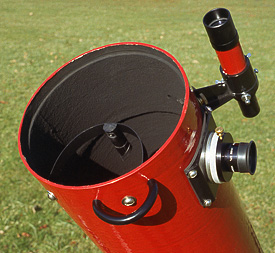
One refractor trait I particularly like is the beautifully clean star images free of diffractions spikes. To reduce these spikes in my Newtonian, I first tried a single stalk to support the secondary mirror. While it did minimize the total amount of diffraction, I soon grew tired of seeing a streak of light running through bright stars and planets. So, I set about making a curved secondary support. Because the single curved vane is made of thin steel, it creates less diffraction than a traditional four-vane spider made from the same thickness material. It also spreads the diffracted light into an invisibly faint halo around stars. Even the very bright ones appear as intense, refractor-like, spike-free points of light. (For details on making your own curved-vane spider, check out this article .)
So far I’ve described how I minimized the Newtonian’s shortcomings. But the design in its own right has many advantages. For example, one of the refractor’s irksome problems results from the eyepiece’s placement at the bottom end of the tube, requiring a tall mount for comfortable viewing. Such mounts are prone to vibrate more than squat ones suitable for Newtonians, especially considering that, for a given aperture, refractors tend to be heavier than reflectors. And there are few dewing problems with a reflector, which is an important advantage for those of us observing in moist climates.
Perhaps the Newtonian’s biggest advantage over refractors is its perfect colour correction. While some premium apochromatic refractors have largely eliminated color error, few are perfect. Having always used reflectors, I may be more sensitive to colour errors than some observers, but to my eyes, the pure colours of a Newtonian’s planetary images are aesthetically more pleasing.

Through The Eyepiece
So how does the Big Red One perform? Did my efforts to achieve high contrast and resolution pay off? Happily the answer is yes. I can say without hesitation that the views are the equal of any I’ve seen through a 6-inch instrument. The planets present a wealth of subtle detail. There have been nights of steady seeing in which Jupiter displayed more detail than I could draw.
While expected this scope to perform well on the planets, I didn’t expect the performance I got on deep-sky objects. One particularly memorable morning when I was observing on Mt. Kobau, I had a superb view of the Orion Nebula. Delicate tendrils of nebulosity contrasted with a startlingly black sky. The clear demarcation of the nebulosity reminded me of views I’d had through my 12½-inch Dobsonian equipped with a UHC filter. The 6-inch performed as if it had a full-time UHC filter that worked on objects not typically helped with conventional filters, such as star clusters and galaxies.
In retrospect, the deep-sky performance should not have been a surprise. After all, the very properties that make a great planetary scope also result in a fabulous deep-sky instrument. My experience with the Orion Nebula helped me understand why refractor owners often report deep-sky views that seem out of line with the telescope’s aperture — it’s all a matter of contrast.
Update
Most of the preceding material is from on an article I wrote for the June 1997 issue of S&T. That’s some time ago now, so you might wonder if I would build the same scope today? For the most part I’d say yes. Attention to detail and a long-focus mirror are important if you want the highest-contrast views a given aperture is capable of. That said, I’ve since become more aware of the importance of thermal management — something I now regard as absolutely crucial to optimum performance in a Newtonian. The 6-inch f/9 now sports a cooling fan. (I have a two-part article on the subject on this web site in the Telescope Making section.)
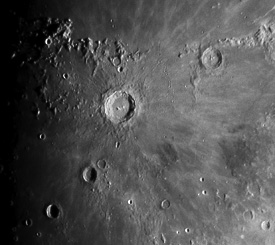
I might also be a little less obsessive about baffling if I were to build the scope knowing what I know today. Don’t get me wrong — baffling is important! However, the crucial region is the section of tube opposite the focuser. This has to be dead black. For the rest of the inside of the tube, it’s less important. (There’s no harm in going the extra distance, it just probably doesn’t make much difference.) Basically, as noted in the article, anything you can see from the focuser is an area of concern.
Finally, everything has to be kept in context. As good as my 6-inch f/9 is, the 8-inch f/6 I built soon after is crushingly superior in virtually every way — including planetary performance. This is something to keep in mind if you’re considering a long-focus Newtonian. A long f-ratio helps, but aperture is much more important. Would an 8-inch f/9 be better than my f/6? Probably. But mounting and using a scope with a tube more than 6 feet long is would be a challenge. And when the aperture gets much bigger, it’s easy to keep the secondary size small without resorting to extremely long focal lengths.
I still use the Big Red One now and then and continue to enjoy its perfect, point-like star images and superb contrast. It’s a very good scope, and the fact that I’ve since built numerous bigger and better ones doesn’t change that.
Did you find this article interesting or helpful? If so, consider using this link the next time you shop at Amazon.com. Better yet, bookmark it for future use. Thanks to Amazon’s associates program, doing so costs you nothing yet helps keep this site up and running. Thanks!
